SLV Frames for luminaires
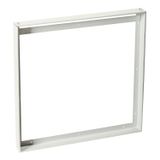
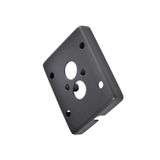
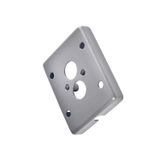

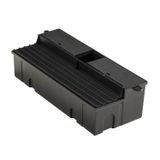
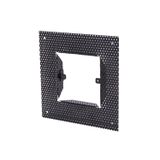



slv frames range and purpose
SLV frames provide the mechanical interface between ceilings, walls, and luminaires so installations land clean, square, and serviceable. Use them to adapt cut-outs, convert surface products to recessed or semi-recessed form, and standardize visible trims across mixed fixture families. Frames are supplied for board, plaster, concrete, and grid ceilings, with options for trim, micro-trim, and trimless plaster-in edges. Typical materials are powder-coated steel or extruded aluminum with corner bracing to keep the bezel flat over time.
slv mounting frames series and form factors
Product families cover single and multi-aperture layouts: round Ø68–Ø90 mm for MR16 and compact LED downlights, square 75–92 mm for small accent heads, and larger 150–200 mm cut-outs for high-output downlights. Multi-lamp bar frames are available in 2/3/4-cell variants for aisle runs or reception counters. Depth collars and adjustable brackets compensate for 9–25 mm plasterboard; spring cages or screw tabs are selected by substrate. Where retrofits meet oversize holes, reducer rings and alignment plates restore the geometry without patching.
Technical specifications and standards
Frames are rated for the luminaire mass and service loads expected in ceilings; typical point loads are documented per aperture. Most interior versions are IP20; pairing with sealed luminaires achieves higher ingress ratings at the optical chamber rather than the frame. Thermal clearances follow the luminaire datasheet—keep insulation away from the rear edge where Tc measurements are taken. Finishes track common SLV colors (white, black, aluminum) with RAL references for consistency. Mechanical conformity aligns with EN 60598 for luminaire mounting integrity; fire and acoustic performance depend on the ceiling system and the selected luminaire, so specify the ceiling board class and any fire hoods separately.
slv recessed frames use cases and interfaces
Use recessed frames to convert free-aim spots or downlights into clean apertures with repeatable edges. Clamping ranges match standard gypsum boards and mineral tiles; anti-rotation features keep square bezels aligned with grid lines. Many models accept torsion springs, butterfly springs, or M4/M5 screws—verify the luminaire leg type before ordering. In concrete ceilings, cast-in or after-fix boxes accept screw-in frames so the visible trim remains replaceable without core drilling.
slv decorative frames finishes and optics
Decorative variants unify the visual language across open offices and hospitality ceilings. Bezel heights from 2–6 mm control the shadow line; micro-bead or matte powder reduces glare around high-lumen sources. For wall washers, asymmetric inner rings align cut-outs while preserving the optic’s tilt. When mixing finishes, keep a single RAL across the sightline to avoid minor color shift under 3000–4000 K ambient lighting.
Applications and compatibility
Retail ceilings benefit from repeatable cut-outs that keep price-rail lighting level across aisles. Museums and galleries use plaster-in trimless frames where the aperture should disappear and maintenance access remains from below. Hospitality corridors often reuse existing holes; reducer rings save patch time and maintain ULOR control. Frames interface cleanly with SLV downlights, adjustable accent heads, and selected pendants with recess adapters; confirm the clamping method and bezel overlap against the luminaire’s flange diameter to avoid visible gaps.
Integration with SLV systems
Frames align with SLV ceiling accessories, remote gear canopies, and adapter plates so electrical and mechanical packages share the same grid. For grid ceilings, match the aperture to T24 module spacing and keep driver access clear of cross-tees. When pairing with controllable luminaires, leave room for DALI or phase-cut drivers in adjacent voids and respect cable bend radii at the frame edge. Where a project calls up slv lighting installation frames, coordinate part numbers with luminaire families so spare bezels remain interchangeable across floors.
Selection criteria for B2B clients
Start with the ceiling type and finished thickness, then select the frame that matches the luminaire’s fixing legs and bezel overlap. Check the cut-out tolerance on drawings—factory-punched holes save fit-off hours compared with on-site hole saws. Choose trimless only when the schedule allows plaster works and sanding; otherwise micro-trim is the safer path. For grid tiles, verify tile load class and use spreader plates where heavy heads are planned. If sightlines matter, order a sample set to validate color and bezel height under project lighting.
Advantages of working with Bankoflamps
You receive individual B2B pricing with a dedicated account manager who maps frames to luminaires, ceiling types, and driver locations using your room data sheets and reflected ceiling plans. Our portal shows live EU stock by warehouse, and quotes usually return in about an hour with EAN/MPN, cut-out sizes, clamping ranges, finish codes, and mounting notes. Orders are placed by code with downloadable, always current price lists and pricing validity windows. We track lead times and order status, provide purchase-history analytics, and offer post-payment up to 30 days for trusted clients. Consolidated shipments by zone reduce site sorting and freight, and we actively support projects in France, the Baltics, Germany, Spain, Italy, Belgium, and the Netherlands.